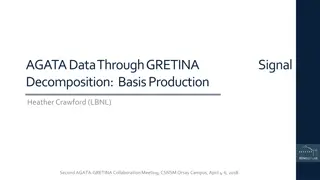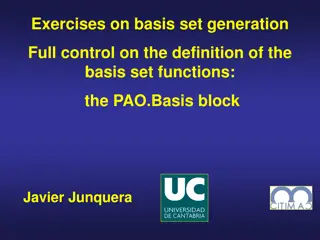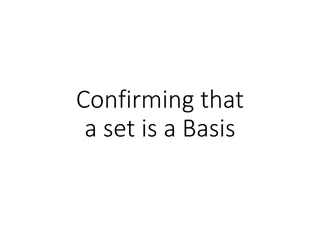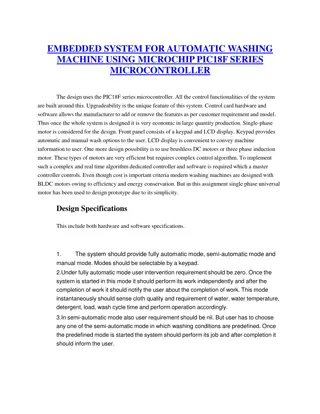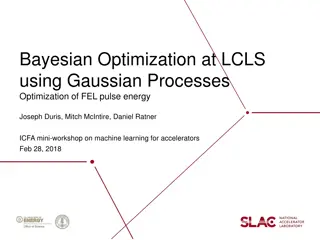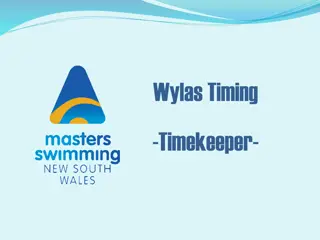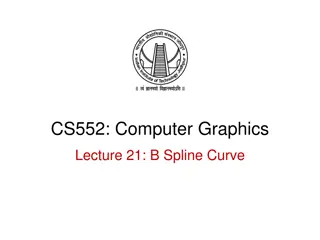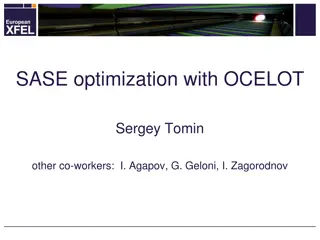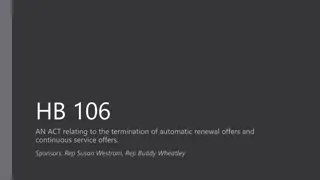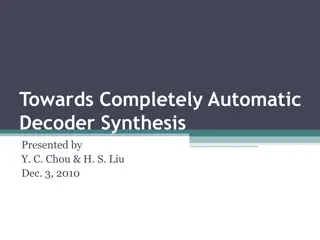Automatic Optimization of Basis Set Parameters for Enhanced Quality
Learn how to automatically optimize the parameters that define the quality of the basis set with the Simplex code, as detailed by Alberto García Javier Junquera. This process involves compiling the Simplex code, preparing the necessary input files, creating a directory for running the optimization for a specific system (e.g., a water molecule), and defining the variables to be optimized using a script file. The TEMPLATE file guides the optimization process, allowing for adjustments to parameters like the soft confinement potential and radii for improved results.
Download Presentation

Please find below an Image/Link to download the presentation.
The content on the website is provided AS IS for your information and personal use only. It may not be sold, licensed, or shared on other websites without obtaining consent from the author. Download presentation by click this link. If you encounter any issues during the download, it is possible that the publisher has removed the file from their server.
E N D
Presentation Transcript
How to optimize automatically the parameters that determine the quality of the basis Alberto Garc a Javier Junquera
Optimization of the parameters that define the basis set: the Simplex code Set of parameters { ,cr Q d ETot = ETot { } d } ,cr ,... Q ,... SIMPLEX Isolated atom Kohn-Sham Hamiltonian + Pseudopotential Extra charge Confinement potential Full DFT calculation of the system for which the basis is to be optimized (solid, molecule,...) MINIMIZATION ALGORITHM Basis set J. Junquera et al. Phys. Rev. B 64, 235111 (2001)
Compiling the Simplex code to automatically optimize the basis set Assuming that you have downloaded and unpacked the Siesta distribution in a directory ~/siesta, go to the ~/siesta/Util/Optimizer directory $cd ~/siesta/Util/Optimizer and type $ make This will compile the simplex using the same arch.make file as the one you to compile siesta
Compiling the Simplex code to automatically optimize the basis set Create a directory to run the simplex for the desired system (in this particular case, the water molecule), and copy there The pseudopotential files The Siesta input file, that in this case will be called TEMPLATE A file with the list of variables over which to optimize, and their ranges of variability, called VARS A file with the tunable operational parameters, called PARAMS The script file which defines the operations that are to be carried out, called run_script.sh
The TEMPLATE file For the meaning of these input variables, read the Siesta Manual In this particular example A soft confinement potential will be used for default for all the atom shells Default value for the prefactor of the soft confinement (for all atoms and shells) Default value for the inner radius of the soft confinement (for all atoms and shells): a fraction of the outer confinement radius determined by the energy shift Some variables are not defined, but kept as variables (with a leading $). Those are the variables that will be optimized in the Simplex minimization. They might change, depending on your particular problem
The TEMPLATE file The VARS file Both files define the variables that will be optimized in the Simplex minimization Match the names that you use in the TEMPLATE (without the leading $ ) with those in the VARS file DO NOT leave any blank lines in the VARS (not even at the end).
The TEMPLATE file The VARS file Minimum value for this variable Maximum value for this variable Starting value (optional) If the starting value is missing, a random starting point in the appropriate range is chosen.
The PARAMS file Tunable operational parameters for the optimization algorithm are defined here it uses a two-level approach, with amoeba-like iterations followed by periodic restarts with new simplex hyper-tetrahedra of progressively smaller sizes Initial criteria Defines the size of the initial hyper-tetrahedron
The PARAMS file Tunable operational parameters for the optimization algorithm are defined here it uses a two-level approach, with amoeba-like iterations followed by periodic restarts with new simplex hyper-tetrahedra of progressively smaller sizes Stopping criteria a minimum fractional size for the hyper-tetrahedron. and a fractional energy tolerance (compared to the differences between the highest and lowest energies of the vertices)
To run an optimization $ ~/siesta/Util/Optimizer/simplex > simplex.out & The driver program (simplex) call the script run_script.sh The script can perform substitutions on suitable template files. The user has nothing to do at this level. $ tail -f simplex.out First: it dumps the information of the VARS and PARAMS files Second: it builds the initial simplex and computes values of the energies at the vertices of the initial simplex Third: it computes the fractional energy tolerance and checks for the convergence criteria Fourth: if not converged, an amoeba-like iterations is performed, searching for the minimum and producing simplex hyper-tetrahedra of progressively smaller sizes
At the end of a successful minimization: the final.sed file It contains the optimized values of the parameters $ more final.sed They can be found also at the end of the output file after running simplex $ tail simplex.out


